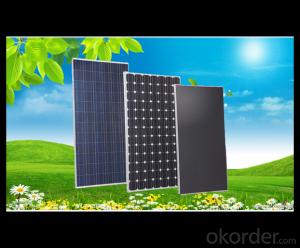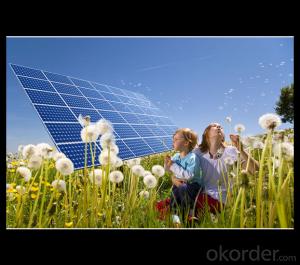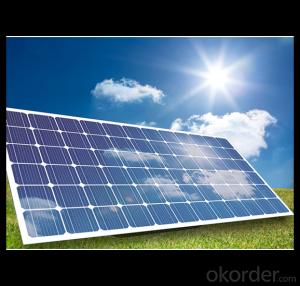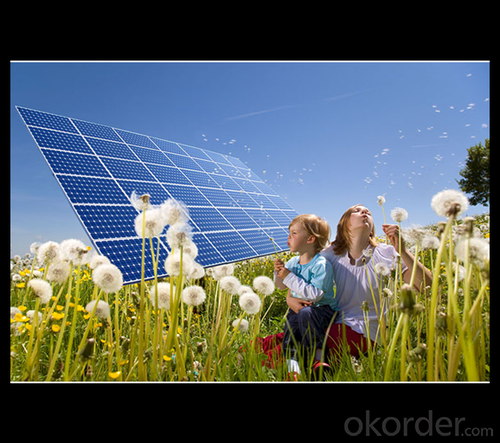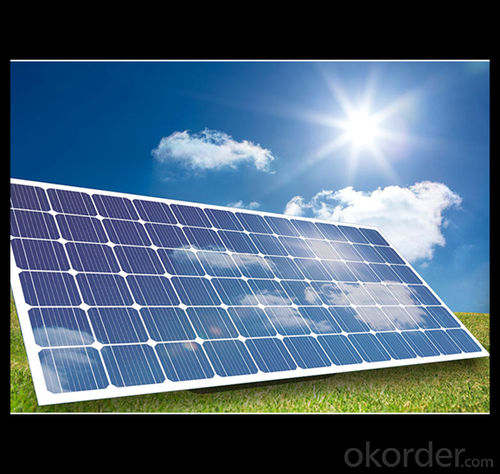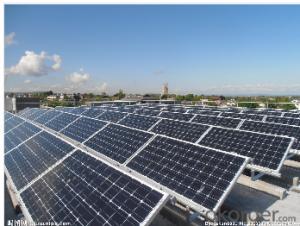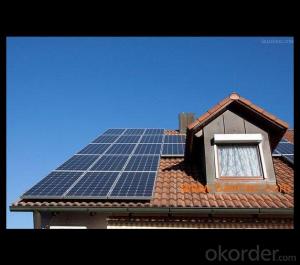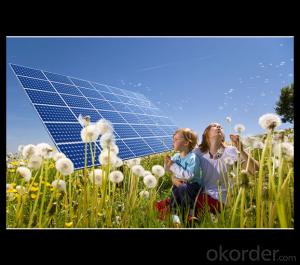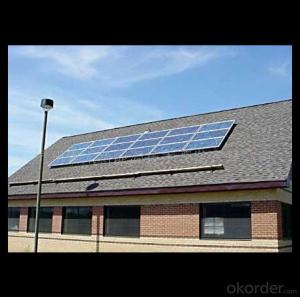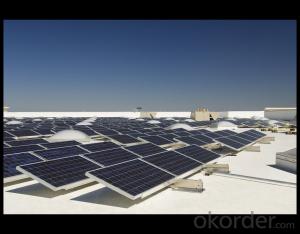Solar Panels for Sale Cheap:250w Direct Factory Sale Price 240-260watt Solar Panels
- Loading Port:
- China main port
- Payment Terms:
- TT OR LC
- Min Order Qty:
- 10000 watt
- Supply Capability:
- 100000 watt/month
OKorder Service Pledge
OKorder Financial Service
You Might Also Like
Specification
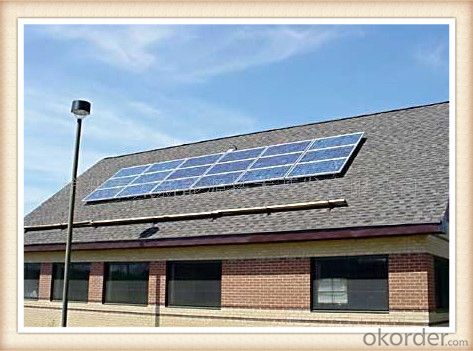
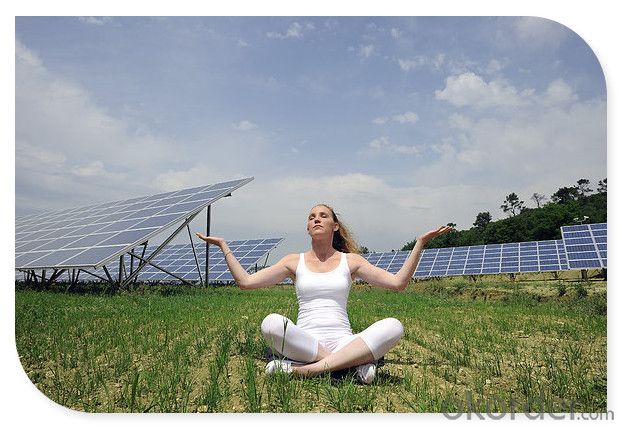
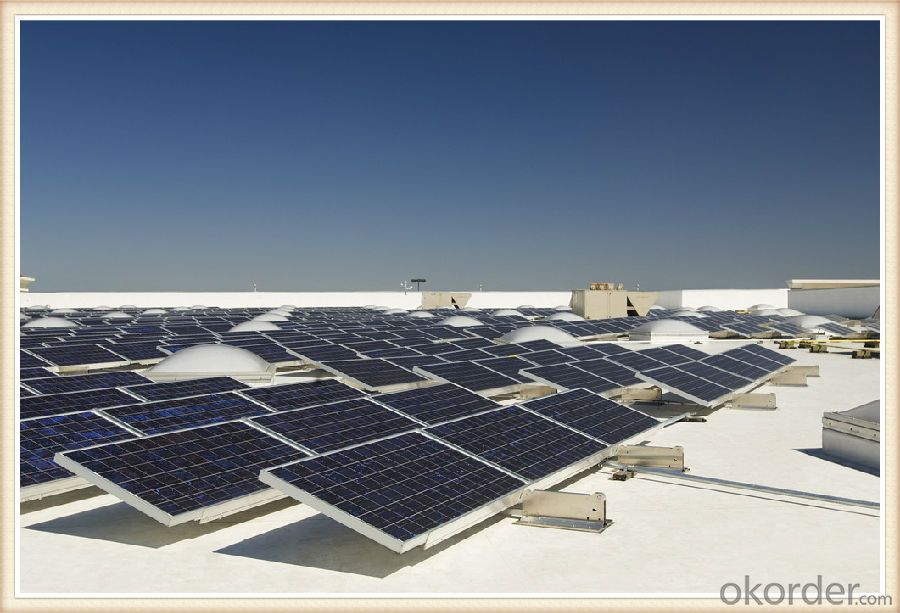
Solar Module Introduction
Solar modules use light energy (photons) from the sun to generate electricity through the photovoltaic effect. The majority of modules use wafer-based crystalline silicon cells or thin-film cells based on cadmium telluride or silicon. The structural (load carrying) member of a module can either be the top layer or the back layer. Cells must also be protected from mechanical damage and moisture. Most solar modules are rigid, but semi-flexible ones are available, based on thin-film cells. These early solar modules were first used in space in 1958.
Electrical connections are made in series to achieve a desired output voltage and/or in parallel to provide a desired current capability. The conducting wires that take the current off the modules may contain silver, copper or other non-magnetic conductive transition metals. The cells must be connected electrically to one another and to the rest of the system. Externally, popular terrestrial usage photovoltaic modules use MC3 (older) or MC4 connectors to facilitate easy weatherproof connections to the rest of the system.
Specification
Model Type | |
Peak Power-Pmax(W) | 5-200W |
Open Circuit Voltage-Voc(V) | 44.2 |
Maximum Power Voltage-Vmp(V) | 36 |
Short Circuit Current-Isc(A) | 5.4 |
Maximum Power Current-Imp(A) | 5 |
Maximum System Voltage | 1000V DC |
Maximum Series Fuse Rating | 10A |
Power Tolerance | -1~+3% |
Temperature Coefficients of Pmax | -0.45%/℃ |
Temperature Coefficients of Voc | -0.348%/℃ |
Temperature Coefficients of Isc | 0.031%/℃ |
Nominal Operating Cell Temperature | 44.5±2℃ |
Standard Testing Condition(STC) | Irradiance:1000W/m²;Temperature:25℃;AM=1.5 |
Qualification Test Parameters | |
Operating Temperature | -40℃~+85℃ |
Storage Temperature | -40℃~+85℃ |
Pressure Bearing | ≥5400Pascal/m² |
Wind Bearing | ≥5400Pascal/m² |
Mechanical Characteristics | |
Cell Size | Mono 125*125mm±0.5 |
No.of Cells | 72pcs(6*12) |
Dimension | 1580*808*40mm |
Weight | 15.5Kg |
Glass | 3.2mm High Transmission,Low Iron |
Frame | Anodized Aluminum Alloy |
Junction Box | IP65Rated |
Internal Diodes | 3 Bypass Diodes |
Cable | 1*4.0mm² Length 900mm |
Images
Packing & Shipping:
We have rich experience on how to pack the panels to make sure the safety on shipment when it arrives at the destination.
The normal size is packed by 25pcs/ carton / pallet. Paper carton for FCL shipping and wood carton for LCL shipping.
Features
1.High reliability with guaranteed -3% to +5% power output tolerance, ensuring return on investment
2.High conversion efficiency based on leading innovative photovoltaic technologies
3.Withstands high wind-pressure and snow load, and extreme temperature variations
4.Attractive appearanceUnique frame design, high mechanical strength, and easy Installation
Warranty:
For c-Si panel: 25years output warranty for no less than 80% of performance, 10 years output warranty for no less than 90% of performance. Free from material and workmanship defects within 5 years.
For a-Si panel: 20 years output warranty for no less than 80% of performance, 10 years output warranty for no less than 90% of performance. Free from material and workmanship defects within 2 years.
•100% product quality protection
•100% on-time shipment protection
•100% payment protection for your covered amount
FAQ:
(1)What price for each watt?
It depends on the quantity, delivery date and payment terms.
(2)What is your size for each module? Can you tell me the Parameter of your module?
We have different series of panels in different output, both c-Si and a-Si. Please take the specification sheet for your reference.
(3)Can you provide the peripheral products of the solar panels, such as the battery, controller, and inverter? If so, can you tell me how do they match each other?
Actually we are only manufacturer of solar panels, but we could try to source them for you in China if you need. We could provide you an optimal system design to instruct you how to install.
(4)Do you have the CE, TUV, UL Certification?
We’ve already passed all the tests, and any certificate is available.
(5)Have you ever sold your products to companies in my country?
Of course, we have customers in all general PV markets, but I think we should expand our market share along with the market growth.
(6)When did your company set up? You are a new company, how can I believe your quality?
We entered into Solar PV industry in 2005, now we have several plants in manufacturing of a-Si and c-Si panels, and our capacity is 220MW per year. Till now we have already passed all the tests by authorized laboratories, e.g. TUV, VDE, UL.
(7)Can you help us install the module if we cooperate with you?
We haven’t entered into installation sector, but we have the plan in near future.
(8) How do you pack your products?
We have rich experience on how to pack the panels to make sure the safety on shipment when it arrives at the destination.
(9) Can you do OEM for us?
Yes, we can.
(10)Can we visit your factory?
Surely, I will arrange the trip basing on your business schedule.
- Q: I'm curious to know if the small solar panels on a calculator (ie TI-32) could produce a voltage similar to what is used in a single-use (disposable) camera, approximately 4V.
- Wrong forum
- Q: what size would the panel be/ I live in the caribbean so plenty of sun!
- What does the advertisement have to do with your question? Yes; BUT, depending on the pump, you may need several panels and possibly an inverter if it is an AC pump. You will ALSO need at least battery in the circuit to provide a load to the panel.
- Q: Can solar panels be used to power a concert venue?
- Yes, solar panels can be used to power a concert venue. Solar panels can generate electricity from sunlight, which can then be used to power various electrical systems in a concert venue, including lighting, sound systems, and other equipment. Additionally, the excess electricity generated by solar panels can be stored in batteries for use during periods of low sunlight or high energy demand. By utilizing solar panels, concert venues can reduce their carbon footprint and contribute to a more sustainable and environmentally-friendly energy source.
- Q: How do solar panels affect the property's LEED certification?
- Solar panels can have a positive impact on a property's LEED certification by contributing towards earning points in various categories such as Energy and Atmosphere, Sustainable Sites, and Materials and Resources. Installing solar panels demonstrates a commitment to renewable energy and can help achieve higher levels of certification within the LEED rating system.
- Q: If you were to shine, for example, heat lamps onto the solar panel along with the sun, will the solar panel eventually not work? Or will they produce more light as long as more light is directed onto them.
- Solar panels have a upper temperature limit, and it's only a bit more than it would reach in a very bright sunny day near the equator. Start shining heat lamps on it and you will raise it past it's max temperature, and it will die. .
- Q: i dont wanna buy a solar panel becuase its too exspensive, i dont want use technical stuff i want to use every day materiels, but i need to know asap plzzzz.
- Solar panel is a sheet of highly expensive, purest Silicon manufactured in a factory of exceptional killingly stringent specifications. You can't do that as a cottage industry, at least the material.
- Q: my solar car works when using the Battery but when there is sunlight i connect the wires to the solar panel and it does not work...................HELP
- leave the car in the sun for a few hours to see if it charges. if not, the panel is defective. get it replaced b4 the science fair
- Q: How long does it take to recoup the cost of solar panels through energy savings?
- The time it takes to recoup the cost of solar panels through energy savings varies depending on factors such as the cost of the panels, the amount of sunlight in the area, the energy consumption of the household, and available government incentives. On average, it can take anywhere between 5 to 20 years to recoup the initial investment. However, with technological advancements and decreasing costs of solar panels, this payback period is steadily decreasing, making solar energy an increasingly attractive and financially viable option for many homeowners.
- Q: How do solar panels affect the property's sustainable development goals?
- Solar panels can greatly contribute to a property's sustainable development goals by providing clean and renewable energy. By harnessing the power of the sun, solar panels reduce reliance on fossil fuels, decrease carbon emissions, and promote environmental sustainability. Additionally, the installation of solar panels can lead to long-term cost savings on electricity bills, enhancing economic sustainability. Overall, solar panels play a crucial role in advancing a property's sustainable development goals by supporting both environmental and economic sustainability.
- Q: are there solar panel that work without the sun?
- No. Solar literally means Sun. But...scientists are working on a panel that can absorb energy after the sun has set. It may be years until we see any commercial success.
Send your message to us
Solar Panels for Sale Cheap:250w Direct Factory Sale Price 240-260watt Solar Panels
- Loading Port:
- China main port
- Payment Terms:
- TT OR LC
- Min Order Qty:
- 10000 watt
- Supply Capability:
- 100000 watt/month
OKorder Service Pledge
OKorder Financial Service
Similar products
Hot products
Hot Searches
Related keywords
